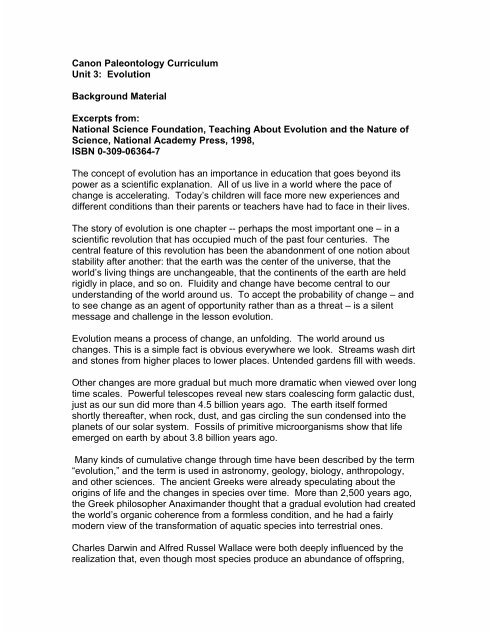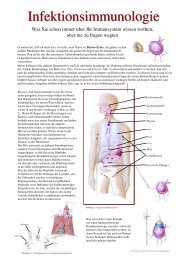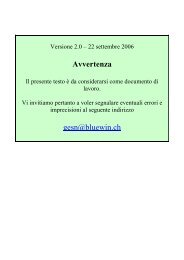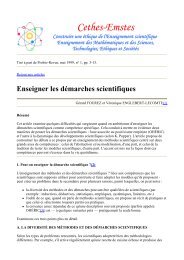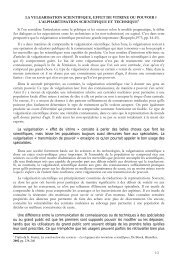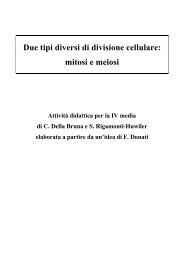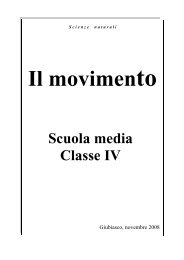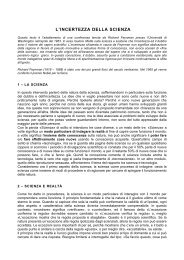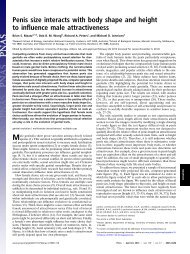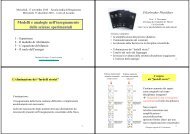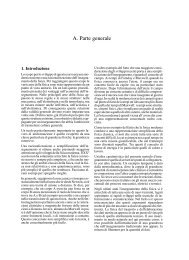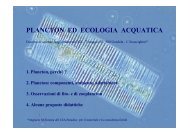Canon Paleontology Curriculum Unit 3
Canon Paleontology Curriculum Unit 3
Canon Paleontology Curriculum Unit 3
You also want an ePaper? Increase the reach of your titles
YUMPU automatically turns print PDFs into web optimized ePapers that Google loves.
<strong>Canon</strong> <strong>Paleontology</strong> <strong>Curriculum</strong><br />
<strong>Unit</strong> 3: Evolution<br />
Background Material<br />
Excerpts from:<br />
National Science Foundation, Teaching About Evolution and the Nature of<br />
Science, National Academy Press, 1998,<br />
ISBN 0-309-06364-7<br />
The concept of evolution has an importance in education that goes beyond its<br />
power as a scientific explanation. All of us live in a world where the pace of<br />
change is accelerating. Today’s children will face more new experiences and<br />
different conditions than their parents or teachers have had to face in their lives.<br />
The story of evolution is one chapter -- perhaps the most important one – in a<br />
scientific revolution that has occupied much of the past four centuries. The<br />
central feature of this revolution has been the abandonment of one notion about<br />
stability after another: that the earth was the center of the universe, that the<br />
world’s living things are unchangeable, that the continents of the earth are held<br />
rigidly in place, and so on. Fluidity and change have become central to our<br />
understanding of the world around us. To accept the probability of change – and<br />
to see change as an agent of opportunity rather than as a threat – is a silent<br />
message and challenge in the lesson evolution.<br />
Evolution means a process of change, an unfolding. The world around us<br />
changes. This is a simple fact is obvious everywhere we look. Streams wash dirt<br />
and stones from higher places to lower places. Untended gardens fill with weeds.<br />
Other changes are more gradual but much more dramatic when viewed over long<br />
time scales. Powerful telescopes reveal new stars coalescing form galactic dust,<br />
just as our sun did more than 4.5 billion years ago. The earth itself formed<br />
shortly thereafter, when rock, dust, and gas circling the sun condensed into the<br />
planets of our solar system. Fossils of primitive microorganisms show that life<br />
emerged on earth by about 3.8 billion years ago.<br />
Many kinds of cumulative change through time have been described by the term<br />
“evolution,” and the term is used in astronomy, geology, biology, anthropology,<br />
and other sciences. The ancient Greeks were already speculating about the<br />
origins of life and the changes in species over time. More than 2,500 years ago,<br />
the Greek philosopher Anaximander thought that a gradual evolution had created<br />
the world’s organic coherence from a formless condition, and he had a fairly<br />
modern view of the transformation of aquatic species into terrestrial ones.<br />
Charles Darwin and Alfred Russel Wallace were both deeply influenced by the<br />
realization that, even though most species produce an abundance of offspring,
the size of the overall population usually remains about the same. Thus, and oak<br />
tree might produce many thousands of acorns each year, but few, if any, will<br />
survive to become full-grown trees.<br />
Darwin proposed that there will be differences between offspring that survive and<br />
reproduce and those that do not. In particular, individuals that have heritable<br />
characteristics making them more likely to survive and reproduce in their<br />
particular environment will, on average, have a better chance of passing those<br />
characteristics on to their own offspring. In this way, as many generations pass,<br />
nature would select those individuals best suited to particular environments, a<br />
process Darwin called natural selection. Over very long times, Darwin argued,<br />
natural selection acting on varying individuals within a population of organisms<br />
could account for all the great variety of organisms we see today, as well as for<br />
the species found as fossils.<br />
One common misconception among students is that individual organisms change<br />
their characteristics in response to the environment. In other works, students<br />
often think that the environment acts on individual organisms to generate<br />
physical characteristics that can then be passed on genetically to offspring. But<br />
selection can work only on the genetic variation that already is present in any<br />
new generation, and genetic variation occurs randomly, not in response to needs<br />
of a population or organism. In this sense, as Francois Jacob has written,<br />
evolution is a “tinkerer, not an engineer.” Evolution does not design new<br />
organisms; rather, new organisms emerge from the inherent genetic variation<br />
that occurs in organisms.<br />
Genetic variation is random, but natural selection is not. Natural selection tests<br />
the combinations of genes represented in members of a species and allows to<br />
proliferate those that confer the greatest ability to survive and reproduce. In this<br />
sense, evolution is not the simple product of random chance.<br />
The booklet Science and Creationism: A view form the National Academy of<br />
Sciences summarizes several compelling lines of evidence that demonstrate<br />
beyond any reasonable doubt that evolution occurred as a historical process and<br />
continues today. In brief:<br />
• Fossils found in rocks of increasing age attest to the interrelated lineage of<br />
living things, from the single-celled organisms that lived billions of years<br />
ago to Homo sapiens. The most recent fossils closely resemble the<br />
organisms alive today, whereas increasingly older fossils are<br />
progressively different, providing compelling evidence of change through<br />
time.<br />
• Even a casual look at different kinds of organisms reveals striking<br />
similarity among species, and anatomists have discovered that these<br />
similarities are more than skin deep. All vertebrates, for example, from
fish to humans, have a common body plan characterized by a segmented<br />
body and a hollow main nerve cord along the back. The best available<br />
scientific explanation for these common structures is that all vertebrates<br />
are descended form a common ancestor species and that they have<br />
diverged through evolution.<br />
• In the past, evolution relationships could be studied only by examining the<br />
consequences of genetic information, such as the anatomy, physiology,<br />
and embryology of living organisms. But the advent of molecular biology<br />
has made it possible to read the history of evolution that is written in every<br />
organism’s DNA. This information has allowed organisms to be placed<br />
into a common evolutionary family tree in a much more detailed way than<br />
possible from previous evidence. For example comparisons of the<br />
differences in DNA sequences among organisms provide evidence for<br />
many evolutionary events that cannot be found in the fossil record.<br />
Evolution is the only plausible scientific explanation that accounts for the<br />
extensive array of observations summarized above. The concept of evolution<br />
through random genetic variation and natural selection makes sense of what<br />
would otherwise be a huge body of unconnected observations. From the<br />
cumulative evidence presented by scientists, it is no longer possible to sustain<br />
scientifically the view that the living things we see today did not evolve from<br />
earlier forms or that the human species was not produced by the same<br />
evolutionary mechanisms that apply to the rest of the living world.<br />
The following websites may be helpful for information and activities on the Nature<br />
of Science, Evolution, and geology in general.<br />
U.S. Geological Survey website (look for education)<br />
http://www.usgs.gov<br />
University of California Museum of <strong>Paleontology</strong><br />
http://www.ucmp.berkeley.edu<br />
University of Indiana<br />
http://www.indiana.edu
Introduction to <strong>Unit</strong> 3<br />
<strong>Canon</strong> Paleo <strong>Curriculum</strong><br />
<strong>Unit</strong>: 3 Evolution<br />
Adaptations<br />
Evolutionary Process<br />
Making Molds of Fossils<br />
1. Possible slide show on how fossil tell us about past life<br />
2. Learning Tree – adaptation Activity<br />
3. Evolution of Barbellus<br />
4. Barbellus presentations<br />
5. Caminalcules – A<br />
6. Caminalcules - B<br />
7. Make fossil Casts<br />
8. Who Am I? – Worksheet and Key<br />
9. Chocolate Candy Recipe<br />
10. How Do Fossils Show Change?
<strong>Canon</strong> Paleo <strong>Curriculum</strong><br />
<strong>Unit</strong>: 3 Evolution<br />
Lesson Plan 2<br />
Activity Name: Fashion a Fish Overview<br />
Adapted from Project Wild Aquatic<br />
Grades: 9-10<br />
Objectives: Students will describe adaptations of fish to their environments, describe<br />
how adaptations can help fish survive in their habitat and interpret the importance of<br />
adaptations of animals. The major purpose of this activity is for students to investigate<br />
the concept of adaptation in fish.<br />
State Standard Met: Science 3.1, 3.4<br />
Materials: Five cards for each adaptations from the masters provided, mouth, body<br />
shape, coloration, reproduction, art materials, paper.<br />
Background: Aquatic animals are the product of countless adaptations over long periods<br />
of time. These adaptations, for the most part, are features that increase the animals’<br />
likelihood of surviving in their habitat.<br />
When a habitat changes, either slowly or catastrophically, the species of with adaptations<br />
that allow them many options are the ones most likely to survive. Some species have<br />
adapted to such a narrow range of habitat conditions that they are extremely vulnerable<br />
to change. They are usually more susceptible than other animals to death or extinction.<br />
In this activity, the students design a kind of fish. They choose the adoptions that their<br />
fish will have. Each choice they make would actually take countless years to develop. As<br />
these adaptations become part of the fish’s design, the fish becomes better suited to the<br />
habitat in which it lives. Because of the variety of conditions within each habitat, many<br />
different fish can live together and flourish.<br />
The major purpose of this activity is for students to investigate the concept of adaptation.<br />
Lesson Plan:<br />
1. Conduct a class discussion on the value of different kinds of adaptations in animals<br />
and plants. As a part of the discussion ask students to identify different kinds of<br />
adaptations in humans. As a group, categorize these adaptations into the following<br />
groups: protective coloration and camouflage, body shape/forrr4 mouth type/feeding<br />
behavior, reproduction/behavior, response to heat/cold, response to dryness. Have<br />
students come up with other categories into which their organisms might fall.<br />
2. Divide the adaptation cards into five groups of four cards each, one each of coloration,<br />
mouth type, body shape and reproduction.
3. Pass one complete set of cards to each group of students. There might be five<br />
groups with four to six students in each group.<br />
4. Ask students to “fashion a fish7' from the characteristics of the cards in the set they<br />
receive. Each group should create an art form that represents their fish, name the<br />
fish using appropriate binomial nomenclature, describe and draw the habitat for their<br />
fish.<br />
5. Ask each group to report to the rest of the class about the attributes of the fish they<br />
have designed, including identify and describing its adaptations. Ask the students to<br />
describe how this kind of fish is adapted for survival.<br />
6. Discuss as a group, the importance of adaptations in fish and other organisms and<br />
the process by which this might occur.
FASHION A FISH<br />
Adapted from Project Wild Aquatic<br />
OBJECTIVES<br />
Skills:<br />
Students will: 1) describe adaptations of fish to their environments; 2) describe how<br />
adaptations can help fish survive in their habitat; and 3) interpret the importance of<br />
adaptations in animals.<br />
Method:<br />
Students design a variety of fish adapted for various aquatic habitats.<br />
Background:<br />
Aquatic animals are the product of countless adaptations over long periods of time. These<br />
adaptations, for the most part, are features that increase the animals likelihood of surviving<br />
in their habitat.<br />
When a habitat changes, either slowly or catastrophically, the species of animals with<br />
adaptations that allow them many options are the ones most likely to survive. Some<br />
species have adapted to such a narrow range of habitat conditions that they are extremely<br />
vulnerable to change. They are over-specialized and are usually more susceptible than<br />
other animals to death or extinction.<br />
In this activity, the students design a kind of fish. They choose the adaptations that their<br />
fish will have. Each choice they make would actually take countless years to develop. As<br />
these adaptations become part of the fish’s design, the fish becomes better suited to the<br />
habitat in which it lives. Because of the variety of conditions within each habitat, many<br />
different fish can live together and flourish. Some adaptations of fish are shown in the<br />
table that follows.<br />
Subject: Science, Art<br />
Skills: analysis, application, classification, communication, description, drawing,<br />
identification, inference, invention, public speaking, reporting. smallgroup work<br />
Duration: two 30 to 45-minute periods for older students; one or two 20-minute periods<br />
for younger students<br />
Group Size: any; groups of four students each<br />
Setting: indoors or outdoors<br />
Key Vocabulary: adaptation, coloration, camouflage<br />
Appendices: local resources<br />
Materials:<br />
Five cared for each adaptation from the maters povided: Mouth body shape, coloration,<br />
reproduction; art materials; paper.<br />
NOTE: Body shape and coloration are the only cards needed for younger students.
Activity<br />
1. Assign students to find a picture or make a drawing of a kind of animal that has a<br />
special adaptation for example, long necks on giraffes for reaching high vegetation to<br />
eat, large eyes set into feathered cones in the heads of owls to gather light for night<br />
hunting.<br />
2. Conduct a class discussion on the value of different kinds of adaptations to animals.<br />
As a part of the discussion, ask the students to identify different kinds of adaptations<br />
in humans.<br />
3. Pool all of the students’ pictures or drawings of adaptations. Categorize them into the<br />
following groups:<br />
protective coloration and camouflage<br />
body shape/form<br />
mouth type/feeding behavior<br />
reproduction/behavior<br />
other (one or more categories the students establish, in addition to the four above<br />
that will be needed for the rest of the activity)<br />
4. Divide the adaptation cards into five groups of four cards each, one each of coloration,<br />
mouth body shape and reproduction.<br />
5. Pass one complete set of cards to each group of students. There might be five<br />
groups with four to six students in each group. If the class size is larger than about 30<br />
students, make additional sets of adaptation cards.<br />
6. Ask the students to “fashion a fish” from the chacteristics of the cards in the set they<br />
receive. Each group should:<br />
create an artform that represents their fish<br />
name the fish<br />
describe and draw the habitat for their fish class<br />
7. Ask each group to report to the rest of the about the attributes of the fish they have<br />
designed, including identifying and describing its adaptations. Ask the students to<br />
describe how this kind of fish is adapted for survival.<br />
8. Ask the students to make inferences about the importance of adaptations in fish and<br />
other animals.
Extensions<br />
1. Take an adaptation card from any category and find real fish with that adaptation!<br />
NOTE: A collection of books about fish is useful. Do not be as concerned about<br />
reading level as much as profuse illustrations.<br />
2. Look at examples of actual fish. Describe the fish’s “lifestyle” and speculate on its<br />
habitat by examining its coloration, body shape and mouth.<br />
For Students<br />
1. Name two fish adaptations in each of the following categories: mouth, shape,<br />
coloration, reproduction. Then describe the advantages of each of these<br />
adaptations to the survival of the fish in their habitats.<br />
2. Invent an animal that would be adapted to live on Your school grounds. Consider<br />
mouth, shape, coloration, reproduction. food, shelter and other characteristics.<br />
Draw and describe your animal.<br />
ADAPTATION<br />
sucker shaped mouth<br />
elongate upper jaw<br />
elongate lower jaw<br />
duckbill jaws<br />
extremely large jaws<br />
Body Shape<br />
torpedo shape<br />
flat bellied<br />
vertical disk<br />
horizontal disk<br />
hump backed<br />
Coloration<br />
light colored belly<br />
dark upperside<br />
vertical stripes<br />
horizontal stripes<br />
mottled coloration<br />
Reproduction<br />
eggs deposited in bottom<br />
eggs deposited in nests<br />
floating eggs<br />
eggs attached to vegetation<br />
live barriers<br />
ADVANTAGE<br />
feeds on small plants/animals<br />
feeds on prey it looks down on<br />
feeds on prey it sees above<br />
grasps prey<br />
surrounds prey<br />
fast moving<br />
bottom feeder<br />
feeds above or below<br />
bottom dweller<br />
stable in fast moving water<br />
predators have difficulty seeing<br />
it from below predators<br />
have difficulty seeing it from<br />
above<br />
can hide in vegetation<br />
can hide in vegetation<br />
can hide in rocks and on bottom<br />
hidden from predators<br />
protected by adults<br />
dispersed in high numbers<br />
stable until hatching<br />
high survival rate<br />
EXAMPLES<br />
sucker, carp<br />
spoonbill, sturgeon<br />
barracuda, snook<br />
muskellunge, pike<br />
bass, grouper<br />
trout, salmon, tuna<br />
catfish, sucker<br />
butterfish, bluegill<br />
flounder, halibut<br />
sockeye salmon, chub,<br />
razorback<br />
most minnows, perch, tuna,<br />
mackerel<br />
bluegill, crappie, barracuda,<br />
flounder<br />
muskellunge, pickerel, bluegill<br />
yellow and white bass, snook<br />
trout, grouper, rockbass,<br />
hogsucker<br />
trout, salmon, most minnows<br />
bass, stickleback<br />
striped bass<br />
perch, northern pike, carp<br />
guppies
<strong>Canon</strong> Paleo <strong>Curriculum</strong><br />
<strong>Unit</strong>: 3 Evolution<br />
Lesson Plan 3<br />
The Evolution of Barbellus Part A<br />
Supplies: Paper, scissors, rock layers containing fossils of Barbellus in Fig. 1, Barbellus<br />
drawings in Fig. 2, and tape.<br />
Concepts: Using fossil evidence to construct evolutionary history, using structural<br />
characteristics to construct evolutionary history.<br />
Introduction: Evolution can be defined as changes in groups of organisms over time.<br />
There are many things that can cause these changes, but one piece of evidence that<br />
shows us that organisms have changed, is the fossils we find. When living things from<br />
the past are compared to living things today, we can see that things have changed.<br />
Some fossils show us organisms that once lived on earth and are no longer found, such<br />
as the dinosaurs and trilobites.<br />
Fossils are found in sedimentary rocks. These rocks are formed from layers of mud,<br />
sand, and other fine particles (including ash). These sediments turn to rock over millions<br />
of years and any living thing trapped in these sediments become fossilized.
The Evolution of Barbellus Part B<br />
Procedure:<br />
1. Cut out the drawings in Fig. 2, making sure each creature’s name remains with the<br />
picture.<br />
2. Arrange the cut outs on a piece of paper to show the sequence of changes that you<br />
think might have taken place in the genus Barbellus.<br />
3. Use Fig. 1 to decide on the relative ages of the species. Make sure that your<br />
arrangement agrees with the relative ages of the fossils.<br />
4. When all in your group are satisfied with the arrangement, tape each fossil and draw<br />
the branches of your evolutionary tree.<br />
Discussion:<br />
1. Which layer (designated by layers A-F) is the oldest?<br />
Which fossils would be the oldest?<br />
2. Why does the specimen B. opticus not appear above layer E?<br />
3. Since specimen B. subterraneous does not appear until rock layer A, where did it<br />
come from?<br />
4. Name the physical features that you used to group your organisms.<br />
5. Write an essay that explains the evolution of Barbellus in terms of changes in anatomy<br />
and their causes. Their structure should show adaptations to their environment (such<br />
as fins for swimming) so be sure to include this in your explanation.
5.Figure 2
Caminalcules<br />
<strong>Canon</strong> Paleo <strong>Curriculum</strong><br />
<strong>Unit</strong>: 3 Evolution<br />
Lesson Plan 5<br />
Supplies: Drawings of Caminalcules (both living and fossil species), scissors, tape, 1 M<br />
X 1.5 M sheet of paper, meterstick, pencil, removable transparent tape.<br />
Concepts: Using relative age of fossils to determine evolutionary history, using structural<br />
characteristics of fossils to determine evolutionary history, relating an organisms<br />
evolutionary history to current taxonomic placement.<br />
Introduction: This simulation involves studying drawings of members of an imaginary<br />
phylum of animals called “Caminalcules.” Students are asked to construct an evolutionary<br />
tree of these imaginary organisms based on their ages and their structural characteristics.<br />
Students should identify patterns in body plans, hypothesize the environment that these<br />
organisms lived in based on structure, and given the age of the fossils, determine their<br />
placement on an evolutionary tree.<br />
Procedure<br />
Part A :Taxonomy of Living Caminalcules<br />
1. Examine the drawing of the living caminalcules in Figure 1. Start your classification<br />
by placing them in the animal kingdom. (What features indicate that the caminalcules<br />
belong in this kingdom?)<br />
2. Your answer is based on some assumptions about the caminalcules and the functions<br />
of their structures. Further assume the following:<br />
The caminalcules are shown at life size.<br />
There is no information about their ventral surface.<br />
There is no information about their internal structures.<br />
There is no sexual differentiation in the caminalcules.<br />
Adult caminalcules do not vary in size.<br />
There is no information about their young, which may be quite different<br />
from the adults.<br />
There is no information about the functions of their structures.<br />
Each of the caminalcules is a separate species.<br />
3. Cut out the individual caminalcules in Figure l. Look carefully at characteristics such<br />
as their appendages, shape, and color patterns. Based on your study, group similar<br />
species into genera and give each genus a name. Recall that members of a genus<br />
resemble each other more closely than they resemble members of other genera.<br />
Describe the characteristics of each genus.<br />
4. Group the genera into one or more families. Name each family and describe<br />
its characteristics.
5. Assume the caminalcules all belong to the same order and class. Create and name a<br />
new order and class.<br />
6. Create a new name for each species. Record each binomial name using the correct<br />
format.<br />
7. Discuss your classification with those of other teams in the class. Try to come to a<br />
class consensus for a single classification.<br />
Living Caminalcules Fig. 1
Procedure: Part B<br />
<strong>Canon</strong> Paleo <strong>Curriculum</strong><br />
<strong>Unit</strong>: 3 Evolution<br />
Lesson Plan 6<br />
1. Figure 2 shows fossil caminalcules. Each drawing is a separate species and each<br />
species has a number. The number in parentheses is the age of the fossil in millions<br />
of years ago. Assume the following about the fossil caminalcules<br />
There is as much information about each fossil caminalcules as about the living<br />
specimens.<br />
The exact age of each fossil is known to the closest 1 million years.<br />
2. To determine the evolutionary relationships of the caminalcules, construct a<br />
phylogenetic tree. Use the meter stick to make 20 equally spaces horizontal lines<br />
about 5 cm apart on the large sheet of paper. Label the bottom line 19 and number<br />
upward so the top line is labeled 0. These numbers represent time intervals of one<br />
million years.<br />
3. Cut out the fossil caminalcules in Fig. 2 and put them in piles according to their age<br />
(the number in parentheses). Beginning at the bottom of the tree, place the species<br />
on the line that match their age. Place the living caminalcule species cut out from Fig.<br />
1 on the 0 line. Use a small piece of removable transparent tape to hold each<br />
caminalcule temporarily in place.<br />
4. Determine the most likely relationships of the fossil caminalcules to other fossil or<br />
living caminalcules. Start your phylogenetic tree by placing the oldest fossil at the<br />
bottom of the paper on the 19 million years line. Arrange the caminalcules to reflect<br />
their relationships. Some fossils have the same species number as other fossil or<br />
living species; place these vertically above and below each other. Place the other<br />
fossil species near those that match as closely as possible newer fossil and/or living<br />
caminalcules.<br />
5. Draw lines that indicate the relationships. A fossil species can be the ancestor or<br />
none, one or two other species at a branching point, but not of three. Sometimes<br />
there is no branching and the transition from one species to another is direct. Connect<br />
species that evolved from another species by slanted lines, not vertical ones. Use<br />
vertical lines only when the species has not evolved into a new species.<br />
6. Because of the incomplete nature of the fossil record and different ways of interpreting<br />
the available fossils, more than one phylogenetic tree is possible. Compare your tree<br />
with that of another team. After discussing the differences and each team’s rationale<br />
for its decisions, produce a revised tree.
Figure 2. Fossil Caminalcule
Figure 2. Fossil Caminalcule (cont.)<br />
This Image is missing or corrupt
Author’s Key of the Caminalcules Phylogenetic Tree<br />
Discussion Questions<br />
1. Answers will vary with how closely the students’ trees agree with the key. Students<br />
should compare their original classification of the living Carninalcules and see if their<br />
genera share a common ancestor. If not, they will need to rename their living species<br />
or revise their tree.<br />
2. Students should identify which living species would need to be renamed based on<br />
their phylogenetic tree.
3. Examples of convergent evolution include the following:<br />
The claws of species 3 and 12 (their most recent common ancestor, species 46, did<br />
not have claws) The wings of 61 and 51 and of 19 and 20<br />
The single (fused) eye of species 16 and I (their shared common ancestor is<br />
species 63)<br />
The forelimb of species 16, 24, and I looks like that of species 9, but actually is a<br />
modified digit The head ornaments of species 12 and 3<br />
4. Examples of vestigial structures include the following:<br />
The reduced digits of species 35<br />
The reduced feet of species 22.<br />
The small digit of species 66<br />
5-6. Answers will vary, depending on whether students judge success to be long times of<br />
evolutionary stability or short times of evolutionary change. Students should justify<br />
their answers with their rationale of why one would be better than another.<br />
7. The evolution of species 46 to 19 and 20, of 33 to 9, and of 52 to 14, 13, and 28.<br />
8. The evolution of species 43 to 4, 3, 22, 12, 2, 16, 42, and 1. Relatively rapid<br />
environmental change might account for rapid changes in structure.<br />
9. Lineages 13, 14, 40 and 46. Relatively unchanging environmental conditions might<br />
account for stability in structural characteristics.
Discussion<br />
1. Do the evolutionary relationships shown in your phylogenetic tree require any changes<br />
in your original classification of living caminalcules? Compare the grouping on line 0<br />
with the way you classified the caminalcules in Part A. If necessary, revise your<br />
classification so it agrees with your phylogenetic tree. All members of a genus should<br />
have the same genus name and should share a common ancestor that is not shared<br />
by members of other genera. The same rule applies to families, orders, classes, etc.<br />
2. Does this revision make necessary a change in the genus and species names you<br />
gave some of the caminalcules? If you had to revise your phylogenetic tree and the<br />
scientific names you gave the living caminalcules, that does not necessarily mean<br />
your first tree or your original names were incorrect. Biologists continually revise their<br />
classification as they obtain more data on both living and extinct (fossil) organisms.<br />
3. In your phylogenetic tree, the vertical distance represents time. The horizontal distance<br />
is an indication (in a general way) of how different the species are from one another.<br />
In other words, two species of the same genus should appear closer together on the<br />
tree than species of different genera. Two species that evolved from a common<br />
ancestor will be closer together on the tree than genera that did not evolve from a<br />
common ancestor. As you go back in time, the lines of relationship become closer to<br />
each other than the<br />
4. Comparing living species also helps determine evolutionary relationships between<br />
organisms. In general, the greater the difference between the organisms, the longer<br />
ago they presumably diverged from a common ancestor. Some species, however,<br />
resemble each other because similar structures evolved independently in response<br />
to similar environments or ways of life, and not because they share a recent common<br />
ancestor. This type of evolution is called convergent evolution because unrelated<br />
species seem to converge (become more similar) in appearance. Examples of<br />
convergent evolution include the wings of bats, birds, and insects, or the streamlined<br />
shapes of whales and fishes. Thus, in classifying organisms, you must consider a<br />
number of characteristics rather than just a single one. List all the examples of<br />
convergent evolution you can identify in the fossil and living caminalcules. Look for<br />
two living species with a shared characteristic, such as similarly shaped forelirnbs,<br />
whose common ancestor did not have that characteristic.<br />
5. Sometimes in the evolution of organisms, unused structures become reduced to the<br />
point where they are virtually useless. Examples of such vestigial structures in our<br />
species are the ear muscles and the tail bones. Compare the structures of the living<br />
caminalcules with their ancestors and list any examples of vestigial structures you<br />
can identify. These are structures that appear to be getting smaller and eventually<br />
disappear.
6. Is a successful lineage one that has branched many times and is represented by<br />
many species, or is it one that has changed the least through time? Explain your<br />
answer.<br />
7. Are some lineages more successful than others? What are the characteristics of<br />
these lineages?<br />
8. What evidence in caminalcule evolution indicates that evolution was relatively gradual?<br />
9. What evidence in caminalcule evolution indicates that evolution was relatively * rapid?<br />
What might account for periods of rapid evolution?<br />
10. What evidence in caminalcule evolution indicates long periods of stability when little<br />
evolution took place? What might account for long periods of stability?
Making Fossil Casts<br />
<strong>Canon</strong> Paleo <strong>Curriculum</strong><br />
<strong>Unit</strong>: 3 Evolution<br />
Lesson Plan 7<br />
Supplies:<br />
Molds of the fossils (available from Florissant Fossil Beds National Monument )<br />
Plastic bucket or bowl for mixing the plaster (cottage cheese or yogurt containers<br />
work well)<br />
Hydrocal white cement (this can be obtained from Threewit-Cooper Cement, 2900<br />
Walnut St., Denver CO. 80205, Phone (303) 296-1666). It costs approximately $29.00<br />
for 100 lbs. Local stucco businesses may also carry this product.<br />
Spoons for mixing the plaster<br />
Water<br />
Kitchen Bouquet for staining cast (Kitchen Bouquet can be purchased in the seasoning<br />
section of grocery stores)<br />
Optional: India ink and No. 4 Sable art brush<br />
Concepts: Since it is impractical and unreasonable to study real fossils, this activity<br />
allows students to create fossil casts that have the appearance and detail of the original.<br />
Introduction: This activity will allow you to make beautiful fossil casts from molds of two<br />
of the Florissant fossils. The molds are of the fossil wasp, the emblem of the monument,<br />
and the branches and cone of the fossil Sequoia.<br />
Procedure<br />
1. Begin by washing the mold by putting a small amount of soap or detergent, add water,<br />
rub gently and pour the water our. Leave the mold damp but not dry. The soap will<br />
act as a wetting agent.<br />
2. Use the plastic container to mix the plaster. In order to determine how much water you<br />
will need for the plaster, fill your latex mold with water and then pour this water into a<br />
clean bowl or bucket. Discard about 1/3 of this water.<br />
3. Carefully sprinkle the plaster powder into the container of water, being careful to sift<br />
the plaster evenly all the way to the edges. This is important because the plaster<br />
must accumulate in the water evenly. You must try to avoid creating a peak in the<br />
middle of the bowl, but evenly distribute the plaster into the water. Continue this until<br />
the water will no longer absorb the plaster, leaving a little dry powder on the surface.
4. Once enough plaster has been sifted to nearly the top of the water, you can begin to<br />
stir the mixture carefully and slowly with a spoon. Keep the contained tilted at an<br />
angle to allow you to stir, keeping the spoon below the water level and keeping air<br />
bubbles to a minimum. It is important to keep air bubbles to a minimum.<br />
5. When the mixture is ready to pour, it should have the consistency of heavy cream or<br />
cake batter.<br />
6. Pour the mixture slowly and steadily into the mold. Roll and tip the mold during the<br />
pouring to insure that air bubbles are released. Tilt, tap gently and rotate the mold<br />
until all the trapped air bubbles have been released.<br />
7. The cast is now left out in an open area and allowed to dry completely. When<br />
completely dryed, gently remove the cast from the mold, being careful not to break<br />
the cast. When finished, the latex mold should be completely washed and allowed to<br />
dry.<br />
8. You can now stain the replica by creating a solution of Kitchen Bouquet and water. It<br />
takes approximately a 5:1 ratio of water to Kitchen Bouquet to get the color of the<br />
fossil shales. You can experiment with this to achieve the desired color. Dip the<br />
replica into the solution, and set out to dry.<br />
9. You may also use a solution of Kitchen Bouquet and India ink to “paint” the fossil but<br />
this requires a very tiny art brush and very fine motor skills, which might be difficult for<br />
young children.
Making Fossil Chocolates<br />
Supplies:<br />
<strong>Canon</strong> Paleo <strong>Curriculum</strong><br />
<strong>Unit</strong>: 3 Evolution<br />
Lesson Plan 9<br />
Chocolate Candy Recipe<br />
1 cup butter<br />
1 ½ box powdered sugar<br />
1 can Eagle brand milk<br />
18 oz. chocolate chips (semi-sweet, or 1/8 block almond bark=12 oz. chocolate chips)<br />
¾ block or paraffin<br />
Optional-<br />
1 can coconut<br />
2 cups nuts chopped<br />
Melt butter, sugar, milk, chocolate and paraffin in double boiler until smooth. Add optional<br />
items just before pouring. Stir to blend only. Pour into molds and refrigerate until hard.<br />
Pull from mold and ice.<br />
Concepts: Students will have an opportunity to make fossil replicas out of chocolate.<br />
Introduction: Students can have fun making candy from fossil molds and creating unique<br />
gifts for members of their family and friends.<br />
Procedure: Make sure that the fossil molds are clean before pouring chocolate into<br />
them. You can use a mild bleach mixture to soak them in and then be sure to rinse<br />
thoroughly before using. Once the chocolate is removed from the molds, be sure to wash<br />
them again thoroughly with a mild soap.<br />
(Footnotes)<br />
* This investigation was adapted from the BSCS Green Version, 8’b Edition, Teachers Resource Manual,<br />
Supplementary Investigation 15, pp. 151-158,1997.
<strong>Canon</strong> Paleo <strong>Curriculum</strong><br />
<strong>Unit</strong>: 3 Evolution<br />
Lesson Plan 10<br />
Name _____________________<br />
Class _____________________<br />
Period ____________________<br />
How Do Fossils Show Change?<br />
Most organisms live, die, and decompose. They leave no traces of having<br />
lived. Under certain conditions, an organism’s remains or tracks may be preserved<br />
as a fossil. Fossils give clues about how an organism looked and where it lived.<br />
They are often used by scientists as evidence of change.<br />
A fossil is any remains of a once living thing. Fossils may only be the outline<br />
of some plant, animal, or other organism that is preserved in rock. Sometimes,<br />
entire skeletons of animals that lived millions of years ago are found.<br />
OBJECTIVES<br />
In this activity, you will:<br />
a. examine diagrams of fossil horses and present-day horses shown in their surroundings.<br />
b. examine diagrams of the structure of the front foot of fossil horses and presentday<br />
horses.<br />
c. note the changes in horses that have taken place over time.<br />
KEYWORDS<br />
Define the following keywords:<br />
adaptation - a variation that helps a living organism survive<br />
Equus - modern horse<br />
fossil - remains of a once-living organism<br />
Hyracotherlum - fossil horse -- extinct<br />
natural selection - an organism's ability to adapt to its enviroment.<br />
MATERIALS<br />
metric ruler<br />
colored pencils: red, blue, green, and yellow<br />
PROCEDURE<br />
Part A. Change in Size With Time<br />
1. Examine the diagrams in Figure I of Uyracothe-rium, Miohippm, Merychippm, and<br />
Equus.<br />
2. Use the diagrams to fill in Table 1.
Name _____________________<br />
Class _____________________<br />
Period ____________________<br />
Part B. Changes in Bone Structures With Time<br />
The changes in horses over the last 55 million years have been shown by studies of<br />
large numbers of fossils. The earliest kind of horse was small and had teeth that were<br />
adapted to browsing on young shoots of trees and shrubs. The present-day horse is<br />
much larger and has larger teeth that are adapted to grazing on the tough leaves of<br />
grasses. Early horses were adapted to living in wooded, swampy areas where more<br />
toes were an advantage. The single-hoofed toes of the present-day horse allow it to<br />
travel fast in the plains.<br />
1. Examine the diagrams in Figure 2. They show fossils of the front foot bones and<br />
the teeth of horses. The foot bones at the upper right of each diagram indicate<br />
the relative bone sizes of each kind of horse.
2. Look for and color the following kinds of bones for each fossil horse.<br />
a. Color the toe bones red, these are marked for you with an x.<br />
b. Color the foot bones blue, these are marked with a y.<br />
c. Color the ankle bones green, these are marked with a w.<br />
d. Color the heel bones yellow, these are marked with a z.<br />
3. Using the diagrams in Figure 2, make measurements to fill in Table 2.<br />
Table 2. Evolution of the Horse<br />
Kind of horse Hyracotherium Miohippus Metychippus Equus<br />
Number of toes 4 3 3 1<br />
Number of toe bones 12 9 9 3<br />
Number of foot bones 4 3 3 3<br />
Number of ankle bones 7 6 4 4<br />
Number of heel bones 1 1 1 1<br />
Total number of foot bones 24 19 17 11<br />
Length of foot (mm) 9 (13) 14(17) 24(25) 35(33)<br />
Height of teeth (mm) 15 15 19 37<br />
QUESTIONS<br />
1. What changes occurred in the surroundings of horses from Hyracotherium to Equus?<br />
2. What change occurred in the shape of the horse from Hyracotherium to Equus?<br />
3. What changes occurred in the size of the horse from Hyracotherium to Equus?<br />
4. As the surroundings changed, what happened to the teeth of the horse?<br />
5. Describe the overall changes in foot length, number of toes, and size of toes in the horse<br />
over time.<br />
6. How would natural selection have caused changes in the size, feet, and teeth of the<br />
horse?
Key for the Teacher<br />
Name _____________________<br />
Class _____________________<br />
Period ____________________<br />
Part B. Changes in Bone Structures With Time<br />
The changes in horses over the last 55 million years have been shown by studies of<br />
large numbers of fossils. The earliest kind o ,f horse was small and had teeth that<br />
were adapted to browsing on young shoots of trees and shrubs. The present-day<br />
horse is much larger and has larger teeth that are adapted to grazing on the tough<br />
leaves of grasses. Early horses were adapted to living in wooded, swampy areas<br />
where more toes were an advantage. The single-hoofed toes of the present-day<br />
horse allow it to travel fast in the plains.<br />
1. Examine the diagrams in Figure 2. They show fossils of the front foot bones and<br />
the teeth of horses. The foot bones at the upper right of each diagram indicate<br />
the relative bone sizes of each kind of horse.
Key for the Teacher<br />
2. Look for and color the following kinds of bones for each fossil horse.<br />
a. Color the toe bones red, these are marked for you with an x.<br />
b. Color the foot bones blue, these are marked with a y.<br />
c. Color the ankle bones green, these are marked with a w.<br />
d. Color the heel bones yellow, these are marked with a z.<br />
3. Using the diagrams in Figure 2, make measurements to fill in Table 2.<br />
Table 2. Evolution of the Horse<br />
Kind of horse Hyracotherium Miohippus Metychippus<br />
Equus<br />
Number of toes<br />
Number of toe bones<br />
Number of foot bones<br />
Number of ankle bones<br />
Number of heel bones<br />
Total number of foot bones<br />
Length of foot (measure inset diagrams) (mm)<br />
Height of teeth (mm)<br />
QUESTIONS<br />
1. What changes occurred in the surroundings of horses from Hyracotherium to Equus?<br />
2. What change occurred in the shape of the horse from Hyracotherium to Equus?<br />
3. What changes occurred in the size of the horse from Hyracotherium to Equus?<br />
4. As the surroundings changed, what happened to the teeth of the horse?<br />
5. Describe the overall changes in foot length, number of toes, and size of toes in the horse<br />
over time.<br />
6. How would natural selection have caused changes in the size, feet, and teeth of the<br />
horse?
Table 1. Evolution in the Horse<br />
Horse Miohippus Merychippus Merychippus Equus<br />
Size 38CM 65CM 100CM 140CM<br />
Type of<br />
Swamp<br />
dry with trees grasslands grasslands<br />
surroundings dense forest and dhrubs<br />
QUESTIONS<br />
1. What changes occurred in the surroundings of horses from Hyracotherium to Equus?<br />
the land became drieer forest and heavy vegetation replaced by grasses<br />
and plains<br />
2. What change occurred in the shape of the horse from Hyracotherium to Equus?<br />
early horses were small and had curved backs<br />
todays horse are much larger with straight backs<br />
3. What changes occurred in the size of the horse from Hyracotherium to Equus?<br />
the height increased form 38 cm to 140cm<br />
4. As the surroundings changed, what happened to the teeth of the horse?<br />
the teeth become larger and flatter as adaptation to grazing<br />
5. Describe the overall changes in foot length, number of toes, and size of toes in the horse<br />
over time.<br />
the foot increased in length, ankle bones decreased, Number of toes decreased, sign<br />
of side toes became shorter than the central toe which became larger<br />
6. How would natural selection have caused changes in the size, feet, and teeth of the horse?<br />
adaptation to a change in the environment would have given an advantage to horses<br />
that had them these horses would have had a greater chance of surviving that horses not<br />
adapted.
UNIT THREE EXAM<br />
True and False. Put a T Or F by the statements.<br />
_____1. Living things adapt to surrounding have the best chance of surviving.<br />
_____2. Prehistoric leaves and animals are fossils.<br />
_____3. Fossils provide evidence for evolution.<br />
_____4. Life forms that come into existence are said to be extinct.<br />
_____5. Sedimentary rock is layered.<br />
_____6. Evolution depends on desirable traits being passed on to offspring.<br />
Multiple Choice. Put the letter on the line that best completes the sentence.<br />
_____7. A change in the hereditary features of a group of organisms over time is<br />
called:<br />
a. mutation b. variation c. natural selection d. evolution<br />
_____8. Rocks that form in layers of mud, sand, and other fine particles are____<br />
rocks.<br />
a. sedimentary b. igneous c. metamorphic d. clastic<br />
_____9. The structure of a bird’s toes changing over time is an example of:<br />
a. selection b. adaptation c. survival d. development<br />
_____10. The most important advantage an adaptation gives a living thin is to<br />
help it to survive in order that it may:<br />
a. kill b. reproduce c. an adaptation d. selection<br />
_____11. A trait that makes an individual different from others in its species is:<br />
a. a variation b. competition c. adaptation d. selection<br />
_____12. One kind of evidence that life existed in the past is called a:<br />
a: mutation b. fossil c. variation d. selection<br />
Match the phrases with the letter of the correct word. Write your choice on<br />
the line to the left.<br />
A. Adaptation B. Competition C. Natural Selection<br />
_____13. Two robins will struggle over a worm.
_____14. The long beak of a hummingbird is used to sip nectar.<br />
_____15. The mud-colored frog will survive and reproduce in a muddy pond.<br />
_____16. The hollow bones of a bird helps it fly.<br />
_____17. Oak seedlings are rivals for sunlight.<br />
_____18. The hard, cone-shaped beak of the cardinal is used for eating seeds.<br />
_____19. The white rabbit will not survive in a forest environment.<br />
_____20. The flippers of a dolphin are used for swimming.<br />
The diagram shows rock layers with fossils as they might be found. Write<br />
the letter on the line. Two letters may be used, either is correct.<br />
_____21. The layer that has the simplest life forms.<br />
_____22. The layer that has more life forms still alive today.<br />
_____23. The oldest layer.<br />
_____24. The layer with most complex life forms.<br />
_____25. The layer revealing live no longer dependant on living in the ocean.
UNIT THREE EXAM – TEACHER’S KEY<br />
True and False. Put a T Or F by the statements.<br />
__T__1. Living things adapt to surrounding have the best chance of surviving.<br />
__T__2. Prehistoric leaves and animals are fossils.<br />
__T__3. Fossils provide evidence for evolution.<br />
__F__4. Life forms that come into existence are said to be extinct.<br />
__T__5. Sedimentary rock is layered.<br />
__T__6. Evolution depends on desirable traits being passed on to offspring.<br />
Multiple Choice. Put the letter on the line that best completes the sentence.<br />
Two letters may be used, either or both are correct.<br />
_A,D_7. A change in the hereditary features of a group of organisms over time is<br />
called:<br />
a. mutation b. variation c. natural selection d. evolution<br />
__A__8. Rocks that form in layers of mud, sand, and other fine particles are____<br />
rocks.<br />
a. sedimentary b. igneous c. metamorphic d. clastic<br />
__B__9. The structure of a bird’s toes changes over time is an example of:<br />
a. selection b. adaptation c. survival d. development<br />
__B__10. The most important advantage an adaptation gives an organism is to<br />
help it to survive in order that it may:<br />
a. kill b. reproduce c. an adaptation d. selection<br />
__A__11. A trait that makes an individual different from others in its species is:<br />
a. a variation b. competition c. adaptation d. selection<br />
__B__12. One kind of evidence that life existed in the past is called a:<br />
a: mutation b. fossil c. variation d. selection
Match the phrases with the letter of the correct word. Write your choice on<br />
the line to the left.<br />
A. Adaptation B. Competition C. Natural Selection<br />
__B__13. Two robins will struggle over a worm.<br />
__A__14. The long beak of a hummingbird is used to sip nectar.<br />
__C__15. The mud-colored frog will survive and reproduce in a muddy pond.<br />
__A__16. The hollow bones of a bird helps it fly.<br />
__B__17. Oak seedlings are rivals for sunlight.<br />
__A__18. The hard, cone-shaped beak of the cardinal is used for eating seeds.<br />
__C__19. The white rabbit will not survive in a forest environment.<br />
__A__20. The flippers of a dolphin are used for swimming.<br />
The diagram shows rock layers with fossils as they might be found. Write<br />
the letter on the line. Two letters may be used, either or both are correct.<br />
__D__21. The layer that has the simplest life forms.<br />
__A__22. The layer that has more life forms still alive today.<br />
__D__23. The oldest layer.<br />
__A__24. The layer with most complex life forms.<br />
_A,B_25. The layer showing evidence that life is no longer dependant on living<br />
in the ocean.


